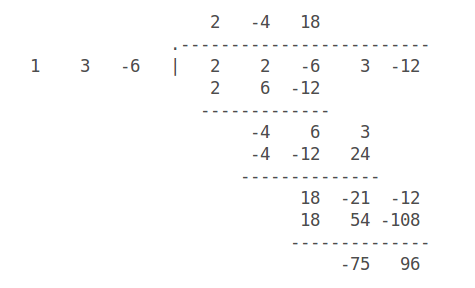How do you divide #(2x^4 + 2x^3 - 6x^2 + 3x - 12)/( x^2 + 3x - 6)#?
1 Answer
Long divide the coefficients to find:
#2x^4+2x^3-6x^2+3x-12#
#= (2x^2-4x+18)(x^2+3x-6) + (-75x+96)#
That is:
#(2x^4+2x^3-6x^2+3x-12)/(x^2+3x-6)#
#= 2x^2-4x+18 + (-75x+96)/(x^2+3x-6)#
Explanation:
I like to long divide the coefficients like this:

Write the dividend under the bar and the divisor to the left of the bar. In our example the dividend
If we had any 'missing' powers of
Then start writing the quotient above the bar, choosing the first term
Write the product of this term and the divisor
Bring down the next term from the dividend alongside this remainder, then choose the next term
Repeat until the 'degree' of the remainder is less than the divisor. In our case the remainder
This is our final remainder.
Being used to long dividing numbers, I find this an easy way to lay out and divide polynomials, but there are more compact ways to represent 'synthetic division'.

